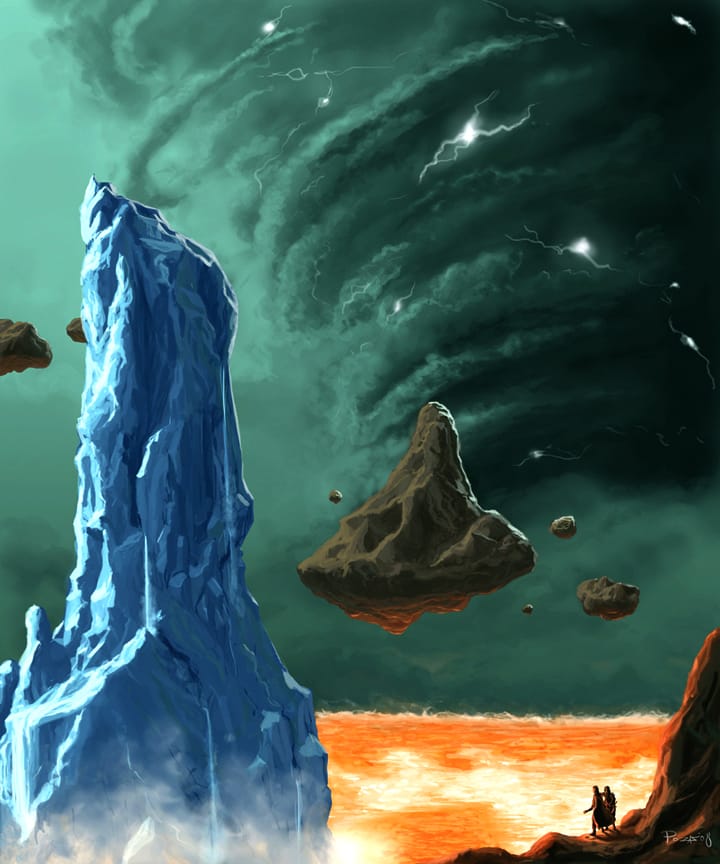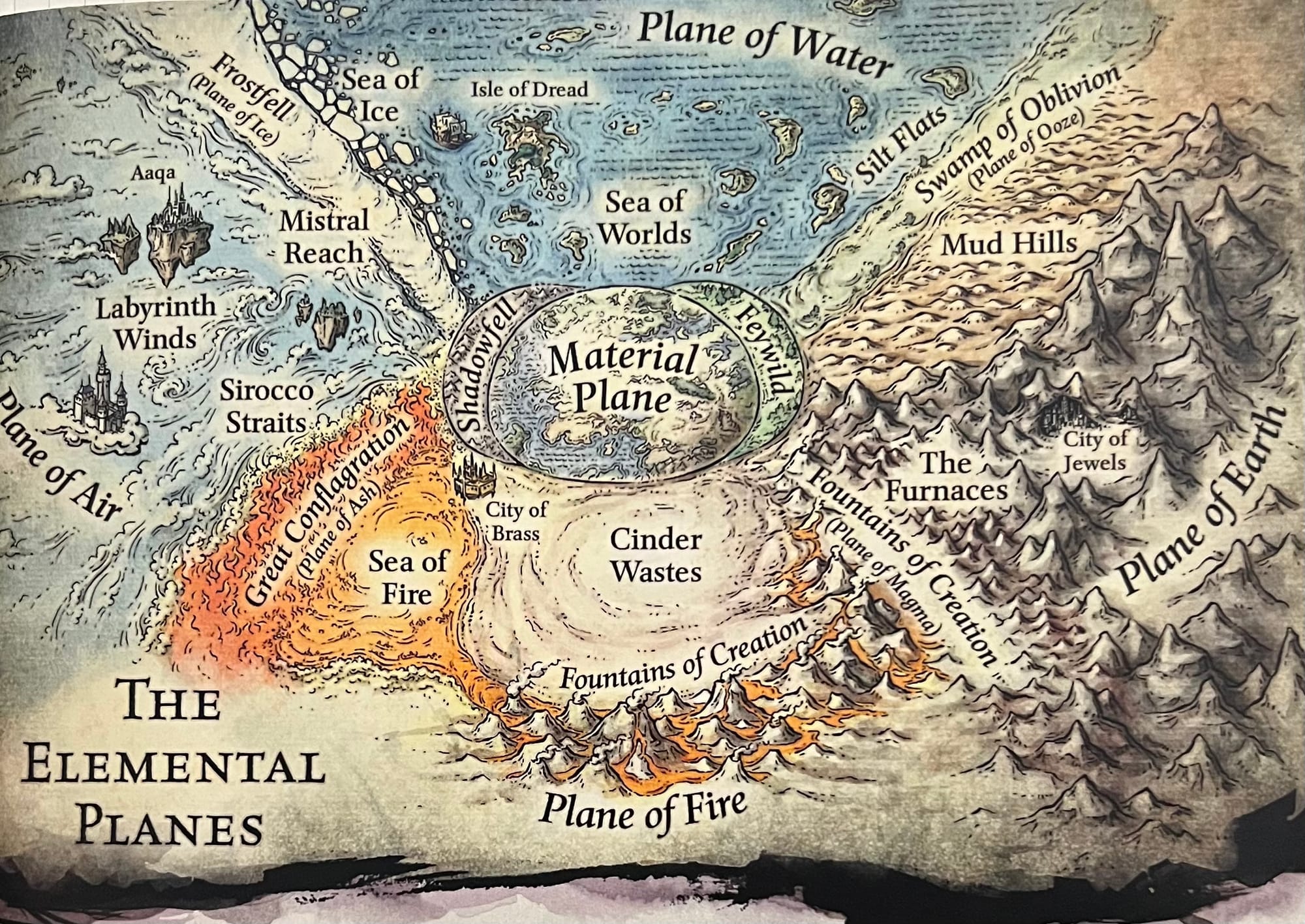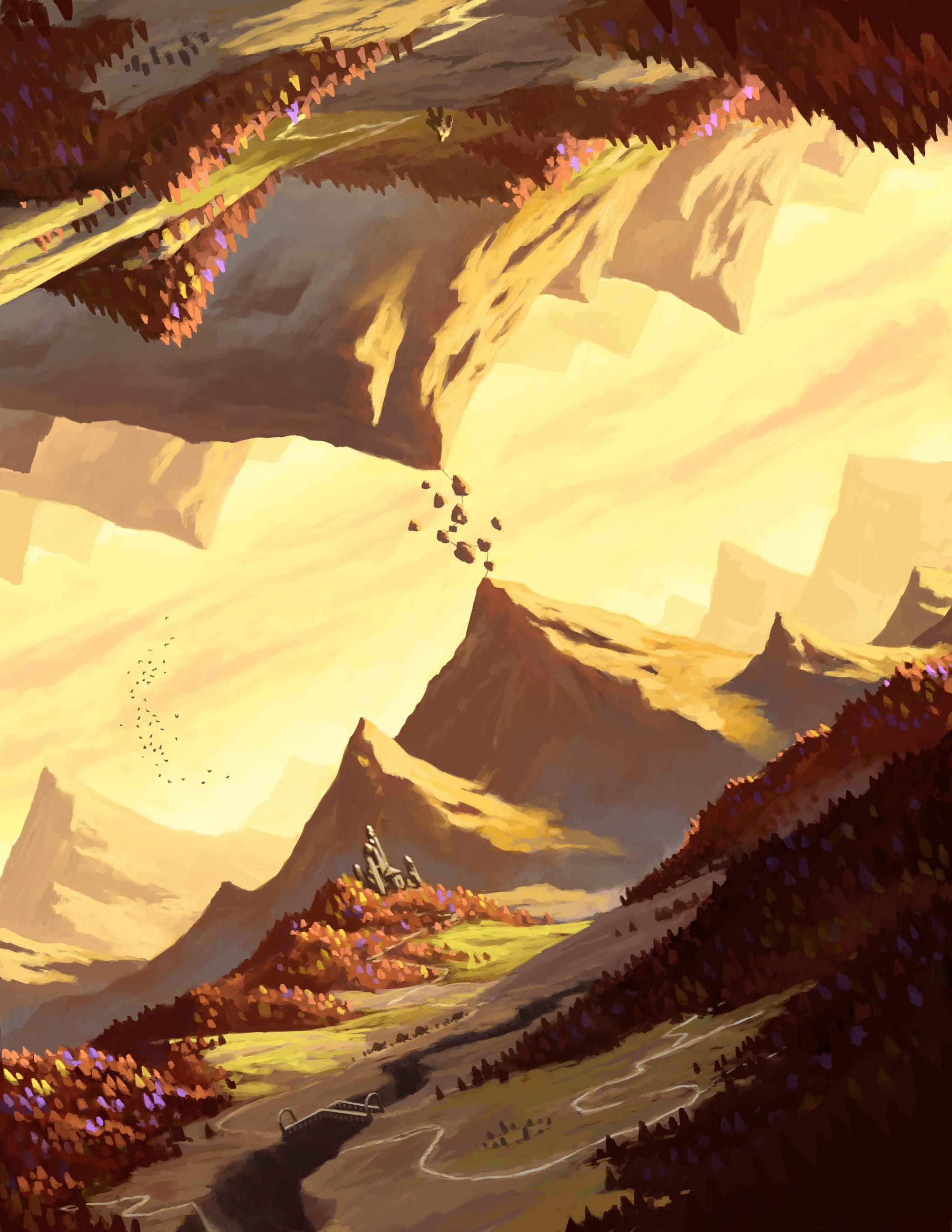The Elemental Planes

The Inner Planes surround and enfold the Material Plane and its echoes, providing the raw elemental substance from which all worlds were made. The four Elemental Planes-Air, Earth, Fire, and Water-form a ring around the Material Plane, suspended within a churning realm known as the Elemental Chaos.

These planes are all connected, and the border regions between them are sometimes described as distinct planes in their own right.
The inhabitants of the inner ring include aarakocra, azers, dragon turtles, gargoyles, genies, mephits, salamanders, and xorn. Some originated on the Material Plane, and all can travel to the Material Plane if they have access to the magic required) and survive there.
As they extend farther from the Material Plane, the Elemental Planes become increasingly alien and hostile. Here, in the outermost regions, the elements exist in their purest form: great expanses of solid earth, blazing fire, crystal-clear water, and unsullied air. Any foreign substance is extremely rare; little air can be found in the outermost reaches of the Plane of Earth, and earth is all but impossible to find in the outermost reaches of the Plane of Fire. These areas are much less hospitable to travelers from the Material Plane than the border regions are. Such regions are little known, so when discussing the Plane of Fire, for example, a speaker usually means the border region.
The outermost regions are largely the domains of elemental spirits barely recognizable as creatures.
The creatures usually called elementals dwell here, including the Elemental Princes of Evil (primordial beings of pure elemental fury) and elemental spirits that spellcasters can bind into galeb duhrs, golems, invisible stalkers, magmins, and water weirds. These elemental creatures don't need food or other sustenance on their home planes, because they are sustained by the elemental energies that saturate those planes.
ELEMENTAL CHAOS
At the farthest extents of the Elemental Planes, the pure elements dissolve and bleed together into an unending tumult of clashing energies and colliding substance called the Elemental Chaos. Elementals can be found here as well, but they usually don't stay long, preferring the comfort of their native planes. Reports indicate the existence of weird hybrid elementals native to the Elemental Chaos, but such creatures are seldom seen on other planes.
PLANE OF AIR
The essential nature of air is movement, animation, and inspiration. Air is the breath of life, the winds of change, the fresh breeze that clears away the fog of ignorance and the stuffiness of old ideas.
The Plane of Air is an open expanse with constant winds of varying strength. Here and there, chunks of earth drift in the openness-the remnants of failed invasions by denizens of the Plane of Earth. These earth motes serve as homes for the creatures of elemental air, and many motes are covered with lush vegetation. Other creatures live on cloud banks infused with enough magic to become solid surfaces, strong enough to support towns and castles.
Drifting cloud banks can obscure visibility in any direction in the plane. Storms are frequent, mostly on par with a strong thunderstorm but occasionally more like fierce tornadoes or mighty hurricanes. The air is mild, except near the Plane of Water (where it is biting cold) and the Plane of Fire (where it is searing hot).
Rain and snow fall only in the part of the plane nearest to the Plane of Water.
Most of the Plane of Air is a complex web of air streams, currents, and winds called the Labyrinth Winds. These range from stiff breezes to howling gales that can rip a creature apart. Even the most skilled flying creatures must navigate these currents carefully, flying with the winds, not against them.
Here and there among the Labyrinth Winds are hidden realms reachable only by following a particular sequence of flowing winds, and thus largely protected against attackers. One such realm is fabled Aaga, a shining domain of silver spires and verdant gardens atop a fertile earth mote. The Wind Dukes of Aaqa are dedicated to law and good, and they maintain a vigilant watch against the depredations of elemental evil and the encroachment of the Elemental Chaos. They are served by aarakocra and a little-known race called the vaati.
The region of the Plane of Air nearest the Great Conflagration is called the Sirocco Straits. Hot, dry winds scour the earth motes in this area to dry and barren chunks of rock. Gargoyles and their allies from the Plane of Earth gather here to launch raids into the realm of Aaqa.
Between the Sea of Fire (on the Plane of Fire) and the Sirocco Straits is a towering firestorm called the Great Conflagration, sometimes called the Plane of Ash. Howling winds from the Plane of Air mix with the cinder storms and lava of the Plane of Fire to create an endless storm front—a wall of flames, smoke, and ash.
The thick ash obscures sight beyond a few dozen feet, and the battering winds make travel difficult. Here and there, ash clusters into floating realms where outlaws and fugitives take shelter. At the other end near the frostfell, (the plane of ice that borders the Plane of Water), is a region of frigid winds called the Mistral Reach. These gales drive snowstorms into the Frostfell and away from it, toward the heart of the plane. Earth motes in the reach are covered in snow and ice.

PLANE OF EARTH
Earth symbolizes stability, rigidity, stern resolve, and tradition. The plane's position opposite the Plane of Air in the ring of the Elemental Planes reflects its opposition to almost everything air represents.
The Plane of Earth is a chain of mountains rising higher than any mountain range in the Material Plane.
It has no sun of its own, and no air surrounds the peaks of its highest mountains. Most visitors to the plane arrive by way of caves and caverns that honeycomb the mountains.
The largest cavern beneath the mountains, called the Great Dismal Delve or the Sevenfold Mazework, is home to the capital city of the dao, the City of Jewels.
The dao take great pride in their wealth and send teams across the plane in search of new veins of ore and gemstones to exploit. Thanks to their efforts, every building and significant object in the city is made from precious stones and metals, including the slender gemstone-inlaid spires that top most buildings. The city is protected by a powerful spell that alerts the entire dao population if a visitor steals even a single stone. Theft is punishable by death, with punishment extending to the thief's relatives.
The mountains nearest the Fountains of Creation on the Plane of Fire) are called the Furnaces. Lava seeps through their caverns, and the air reeks of sulfur. The dao have great forges and smelting furnaces here to process their ores and shape their precious metals.
The border region between the planes of Water and Earth is a horrid swamp where twisted, gnarled trees and thick, stinging vines grow from the dense muck and slime. Here and there within the Swamp of Oblivion (also called the Plane of Ooze), stagnant lakes and pools play host to thickets of weeds and monstrous swarms of mosquitoes. The few settlements here consist of wooden structures suspended above the muck. Most are built on platforms between trees, but a few stand on stilts driven deep into the muck. No solid earth underlies the mud of the swamp, so houses built on poles eventually sink down into it.
It is said that any object cast into the Swamp of Oblivion can't be found again for at least a century. Now and then, a desperate soul casts an artifact of power into this place, removing it from the multiverse for a time.
The promise of powerful magic lures adventurers to brave the monstrous insects and hags of the swamp in search of these treasures.
The region of the plane nearest the Swamp of Oblivion is called the Mud Hills. Landslides constantly wear away the slopes of the hills, sending cascades of earth and stone into the bottomless swamp. The Plane of Earth seems to constantly regenerate the land, pushing new hills up as the old ones erode to nothing.

PLANE OF FIRE
Fire represents vibrancy, passion, and change. At its worst, it is cruel and wantonly destructive, as the efreet often are, but at its best, fire reflects the light of inspiration, the warmth of compassion, and the flame of desire.
A blazing sun hangs at the zenith of a golden sky above the Plane of Fire, waxing and waning on a
24-hour cycle. It ranges from white hot at noon to deep red at midnight, so the darkest hours of the plane display a deep red twilight. At noon, the light is nearly blinding. Most business in the City of Brass (see below) takes place during the darker hours.
The weather on the plane is marked by fierce winds and thick ash. Although the air is breathable, creatures not native to the plane must cover their mouths and eyes to avoid stinging cinders. The efreet use magic to keep the cinder storms away from the City of Brass, but elsewhere in the plane, the wind is always at least blustery and rises to hurricane force during the worst storms.
The heat in the Plane of Fire is comparable to a hot desert on the Material Plane, and poses a similar threat to travelers (see "Extreme Heat" in chapter 5, "Adventure Environments"). The deeper one goes into the plane, the rarer water becomes.
Beyond a point, the plane holds no sources of water, so travelers must carry their own supplies or produce water by magic.
The Plane of Fire is dominated by the vast Cinder Wastes, a great expanse of black cinders and embers crossed by rivers of lava. Roving bands of salamanders battle each other, raid azer outposts, and avoid the efreet. Ancient ruins dot the desert-remnants of forgotten civilizations.
A great range of volcanic mountains called the Fountains of Creation is home to azers. These rocky peaks curl from the edge of the Plane of Earth around the Cinder Wastes toward the fiery heart of the plane.
At the edge of the plane, the mountains are also called the Plane of Magma. Fire giants and red dragons make their homes here, as well as creatures from the neighboring planes.
Lava flows through the volcanoes toward the Plane of Air and pools into a great lava sea, called the Sea of Fire, sailed by efreet and azers in great brass ships.
Islands of obsidian and basalt jut up from the sea, dotted with ancient ruins and the lairs of powerful red dragons. On the shore of the Sea of Fire stands the City of Brass.
THE CITY OF BRASS
Perhaps the best-known location in the Inner Planes is the City of Brass, on the shores of the Sea of Fire. This is the fabled city of the efreet, and its ornate spires and metal walls reflect their grandiose and cruel nature.
True to the nature of the Plane of Fire, everything in the city seems alive with dancing flames, reflecting the vibrant energy of the place.
Adventurers frequently come here on quests for legendary magic. If it's possible to buy magic items at all, the City of Brass is the most likely place to find any item for sale, though the prita dinght well be more than gold. The efreet are fond ofand in in favors, specialy golen they have the upper hand in negotiations. Perhaps a magical disease or poison can be cured only with something that must be purchased in the bazaars of the city.
The heart of the city is the towering Charcoal
Palace, where the tyrannical sultan of the efreet reigns supreme, surrounded by efreet nobles and a host of servants, guardians, and sycophants.

PLANE OF WATER
The nature of water is to flow, not like the gusting wind or the leaping flame, but smoothly and steadily. It is the rhythm of the tide, the nectar of life, the bitter tears of mourning, and the balm of sympathy and healing. Given time, it can erode all in its path.
A warm sun ares across the sky of the Plane of Water, seeming to rise and set from within the water at the visible edge of the horizon. Several times a day, however, the sky clouds over and releases a deluge of rain, often accompanied by spectacular shows of lightning, before clearing up again. At night, a glittering array of stars and auroras bedecks the sky.
The Plane of Water is an endless sea, called the Sea of Worlds, dotted here and there with atolls and islands that rise up from enormous coral reefs that seem to stretch forever into the depths. The storms that move across the sea sometimes create temporary portals to the Material Plane and draw ships into the Plane of Water. Surviving vessels from countless worlds and navies ply these waters with little hope of ever returning home.
The weather on the plane is a lesson in extremes.
If the sea isn't calm, it is battered by storms. On rare occasions, a tremor in the planar firmament sends a rogue wave sweeping across the plane, swamping entire islands and driving ships down to the reefs.
Life flourishes in the upper reaches of the Sea of Worlds, called the Sea of Light because of the sunlight filtering down into the water. Aquatic humanoids craft castles and fortresses in the coral reefs. The marids are the distant stewards of this region, content to allow the lesser folk to compete for territory. The nominal emperor of the marids dwells in the Citadel of Ten Thousand Pearls, an opulent palace made of coral and studded with pearls.
The deeper extents of the plane, where no sunlight reaches, are called the Darkened Depths. Horrid creatures dwell here, and the absolute cold and crushing pressure mean a swift end to creatures accustomed to the surface or the Sea of Light. Krakens and other mighty leviathans claim this realm.
Any land that rises above the surface of the sea is hotly contested byche few air breathers that live on the plane. Fleets of rafts and ships lashed together serve as solid ground where nothing else is available. Most natives of the plane never hreak the surface of the sea and thus ignore these habitations.
One of the fee these habitationon the plane is the late of Dread he anal islands on th the Material Plane by means of a regular storm that sweeps over the island. Travelers who know the strange tides and currents of the plane can travel between worlds freely, but the storms also wreck ships from the Material Plane on the island's shore.
The region of the Plane of Water nearest the Swamp of Oblivion (on the Plane of Earth) is called the Silt Flats. The water is thick with soil and sludge, and turns into muddy ground before giving way to the great swamp between the planes.
At the other extreme of the plane is the Sea of Ice, bordering the Frostfell. The frigid water is choked with icebergs and sheet ice, inhabited by the cold-loving creatures that inhabit the Frostfell. Drifting icebergs can carry these creatures farther into the Plane of Water to threaten ships and islands in warmer seas.
The Frostfell, also called the Plane of Ice, forms the border between the planes of Air and Water and is a seemingly endless glacier swept by constant, raging blizzards. Frozen caverns twist through the Plane of Ice, home to yetis, remorhazes, white dragons, and other creatures of cold. The inhabitants of the plane engage in a never-ending battle to prove their strength and ensure
Its dangerous monsters and bitter cold make the Frostfell a dangerous place to travel. Most planar voyagers keep to the air, braving the powerful winds and driving snow to avoid setting foot on the great glacier.

